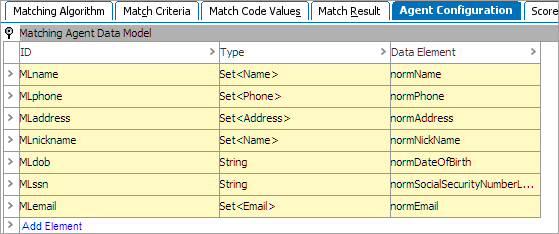In order to function, the machine learning matching agent (MLMA) must point to a matching algorithm. Within the matching algorithm, you must set up the data model, which the MLMA will use when making merge or reject recommendations.
Prerequisites
Configure a matching algorithm and the machine learning matching agent. For more information, refer to the Configuring Matching Algorithms topic (here) and the Configuring the Matching Agent Object Type topic (here).
Setting up the Matching Agent Data Model
-
In the System Setup tab in workbench, select the desired matching algorithm, and go to the Agent Configuration tab.
-
Select the data elements that the matching agent must use to train the machine learning engine. This matching agent data model will be unique to the selected matching algorithm.

Important: For every matching algorithm, there can only be one matching agent data model.
The data elements that can be used are the ones configured on the Match Criteria tab. This way, existing data elements can be reused, or new specific ones can be added.
The matching agent supports data elements returning these types:
-
String
-
Set of strings
Additionally, the matching agent supports all party data matching normalizers:
-
Address normalizer
-
Email normalizer
-
Organization name normalizer
-
Person name normalizer
-
Phone normalizer
Important: The attributes used in the data model must not be set to 'Externally Maintained.' This is required in order to store a correct copy of the clerical review decisions used for the machine learning training.
Data elements returning the same types as the normalizers listed above are supported. Data elements using data from a target reference are not supported, because this level of data is not stored at the point in time where the data steward makes merge / reject decisions in the clerical review task list.
For more information on normalizers and the Match Criteria tab, refer to the Match Criteria Data Elements topic here.
Note: The organization name and person name type are not supported as sets. This means that only one element will be used in the matching agent data model. The matching agent data model will however show the type as Set<Name> and Set<Organizationname>
The user can change the data model at any time. When this is needed, the matching agent must be retrained. All previous merge / reject decisions are persisted on the matching agent, and the changed data model uses these decisions fully. For more information on how the matching agent works, refer to the Matching Agents topic here.